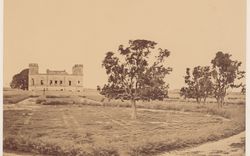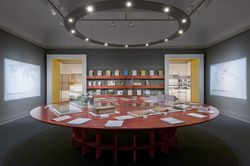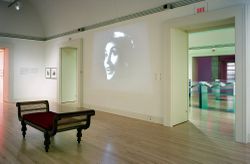articles
Safeguarding Memory in Colonial India
Yakin Kinger explores the politics of commemoration
Actions:
Keep Safe
Maison Coloniale: model
ARCH165838
Description:
Maquette de la Maison Coloniale Note: La maquette nécessite des réparations mineures fabriquée par Ghislain Bélanger
1986-1990
Maison Coloniale: model
Actions:
ARCH165838
Description:
Maquette de la Maison Coloniale Note: La maquette nécessite des réparations mineures fabriquée par Ghislain Bélanger
Shaughnessy House Keyword(s):
research fellow 2022, seminar, research, Desirée Valadares, infrastructure, railway, highway, colonial history
10 November 2022, 6pm
Shaughnessy House Keyword(s):
research fellow 2022, seminar, research, Desirée Valadares, infrastructure, railway, highway, colonial history
articles
Jonas Henderson, Emma Martin, DEW Line, radar, colonial, Distant Early Warning Line, Inuit, indigenous, Stephen Bulger
4 December 2022
Colonial Gazing, Part 1: Pictures to Places
Jonas Henderson and Emma Martin study the DEW Line photographs within the CCA’s collection
Actions:
articles
Jonas Henderson, Emma Martin, DEW Line, radar, colonial, Distant Early Warning Line, Inuit, indigenous, Nunangat, Yukon
10 December 2022
Colonial Gazing, Part 2: The Silent Attack on Inuit Nunangat
Emma Martin and Jonas Henderson study the DEW Line photographs within the CCA’s collection
Actions:
articles
10 December 2022
The beginning of the 1950s was a moment of global upheaval. From India to Morocco, from Guatemala to Indochina, the process of decolonization gained momentum and the Cold War began. Architects working or acting as experts in the non-Western areas of the globe could no longer plan as if sites were terrains vague and people were mute subjects. The end of colonial(...)
Main galleries Keyword(s):
Casablanca, Chandigarh, Le Corbusier, Jeanneret, Morocco, Punjab, India, Morocco, modernism, Africa, Takashi Homma, Yto Barrada
26 November 2013 to 20 April 2014
How architects, experts, politicians, international agencies and citizens negotiate modern planning: Casablanca Chandigarh
Actions:
Description:
The beginning of the 1950s was a moment of global upheaval. From India to Morocco, from Guatemala to Indochina, the process of decolonization gained momentum and the Cold War began. Architects working or acting as experts in the non-Western areas of the globe could no longer plan as if sites were terrains vague and people were mute subjects. The end of colonial(...)
Main galleries Keyword(s):
Casablanca, Chandigarh, Le Corbusier, Jeanneret, Morocco, Punjab, India, Morocco, modernism, Africa, Takashi Homma, Yto Barrada
Between 1836 and 1848, the German-Dutch explorer Franz Wilhelm Junghuhn made several expeditions in Java in the service of the Dutch colonial authorities. He was among the first colonists to climb the island’s many volcanoes. His scientific works, books, maps, and lithographs made him the “Humboldt of Java.” This exhibition follows Junghuhn’s footsteps and explores(...)
Octagonal gallery
29 September 2016 to 22 January 2017
17 Volcanoes: Works by Franz Wilhelm Junghuhn, Armin Linke, and Bas Princen
Actions:
Description:
Between 1836 and 1848, the German-Dutch explorer Franz Wilhelm Junghuhn made several expeditions in Java in the service of the Dutch colonial authorities. He was among the first colonists to climb the island’s many volcanoes. His scientific works, books, maps, and lithographs made him the “Humboldt of Java.” This exhibition follows Junghuhn’s footsteps and explores(...)
Octagonal gallery
Traces of India depicts the social, political, and anthropological role of images, showing how they laid the historical foundations—real and imagined—on which an ordered empire may have been constructed, rather than an assemblage of colonial trading relationships. Organized around six themes, the exhibition explores some of the greatest architectural sites of the Indian(...)
Main galleries
15 May 2003 to 14 September 2003
Traces of India: Photography, Architecture, and the Politics of Representation
Actions:
Description:
Traces of India depicts the social, political, and anthropological role of images, showing how they laid the historical foundations—real and imagined—on which an ordered empire may have been constructed, rather than an assemblage of colonial trading relationships. Organized around six themes, the exhibition explores some of the greatest architectural sites of the Indian(...)
Main galleries
Luca Danese was an architect and hydraulic engineer active in northeastern Italy in the first half of the 17th century. His career, while rooted in the peculiar geography of the Po River Delta, interacted with and was shaped by the broader hydropolitics of the papal government that was busy transforming Rome’s water infrastructure. Further, it was the period when, with(...)
Study Room Keyword(s):
research fellow 2023, seminar, research, Andrea Bagnato, Luca Danese, Italy, 17th century, hydropolitics, water
6 July, 6 p.m.
Research Fellow Seminar: Andrea Bagnato
Actions:
Description:
Luca Danese was an architect and hydraulic engineer active in northeastern Italy in the first half of the 17th century. His career, while rooted in the peculiar geography of the Po River Delta, interacted with and was shaped by the broader hydropolitics of the papal government that was busy transforming Rome’s water infrastructure. Further, it was the period when, with(...)
Study Room Keyword(s):
research fellow 2023, seminar, research, Andrea Bagnato, Luca Danese, Italy, 17th century, hydropolitics, water
Learning from... Cairo
Nasser Rabbat challenges the traditional framing strategies of East vs. West or traditional vs. modern, focusing instead on the dialectical relationship of modernity and history in the making of contemporary Cairo. Shaped by distinct waves of modernity from the colonial Napoleonic invasion of 1789 to the revolution and independence in 1952, the city responded with layers(...)
Paul-Desmarais Theatre
15 September 2011 , 7pm
Learning from... Cairo
Actions:
Description:
Nasser Rabbat challenges the traditional framing strategies of East vs. West or traditional vs. modern, focusing instead on the dialectical relationship of modernity and history in the making of contemporary Cairo. Shaped by distinct waves of modernity from the colonial Napoleonic invasion of 1789 to the revolution and independence in 1952, the city responded with layers(...)
Paul-Desmarais Theatre









